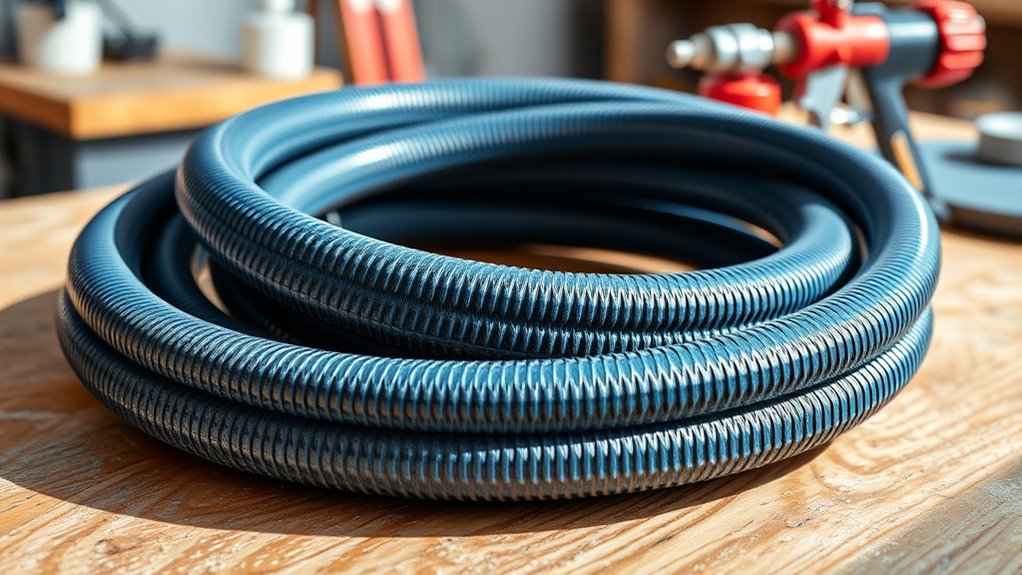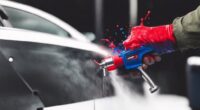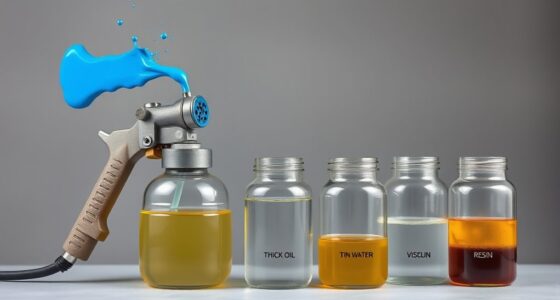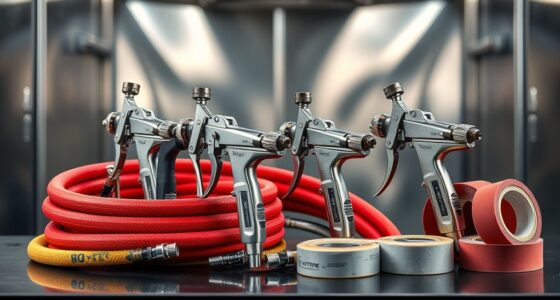Yes, hose length can affect your paint sprayer’s performance. Longer hoses offer more mobility for large areas but can cause pressure drops and uneven spray patterns, impacting coverage and finish quality. Shorter hoses provide better control, easier cleaning, and consistent flow. Balancing hose length with your project size and equipment features is key. Keep exploring to find out how to choose the right hose length for your needs and maximize your results.
Key Takeaways
- Longer hoses increase mobility but cause pressure drops, affecting spray consistency and material flow.
- Shorter hoses offer better control, easier cleaning, and reduce the risk of pressure loss during spraying.
- Hose material and diameter influence flow rate and durability, impacting overall spray performance.
- Proper storage and handling prevent kinks and damage, maintaining optimal spray quality regardless of hose length.
- Using pressure regulation devices can mitigate performance issues caused by longer hoses.
Understanding the Role of Hose Length in Paint Sprayers
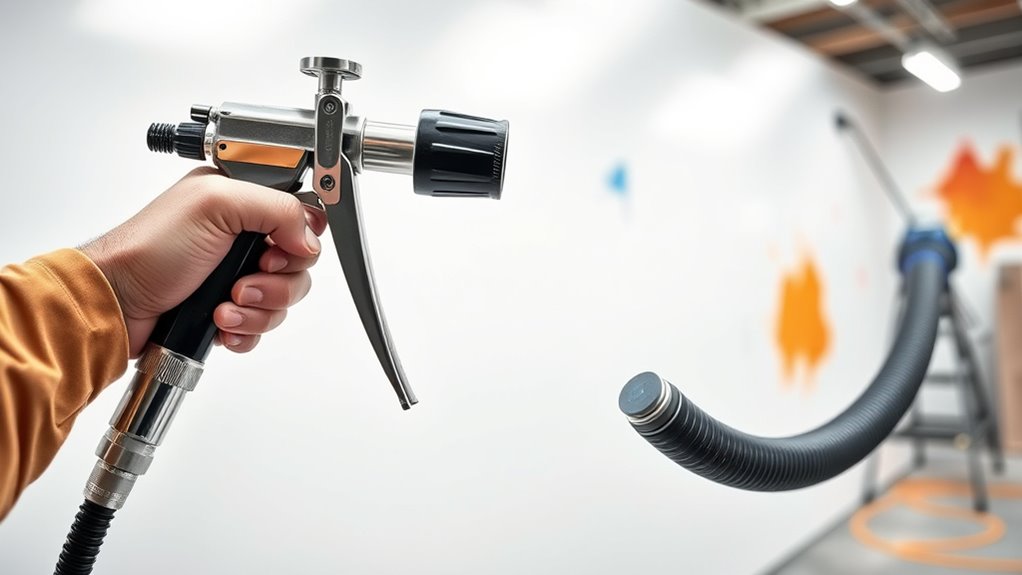
The length of the hose in a paint sprayer directly impacts your ability to work efficiently and achieve a smooth finish. Longer hoses give you more freedom to move around without constantly repositioning the sprayer, but they also require proper hose storage to prevent tangling and damage. When it comes to cleaning methods, longer hoses can be more challenging to clean thoroughly, so you’ll want to take extra care to flush out all paint residues after use. Shorter hoses are easier to manage and clean, but limit your reach. Choosing the right hose length depends on your project size and workspace, ensuring you can work comfortably while maintaining proper hose storage and effective cleaning routines for ideal performance. Additionally, understanding project size and workspace helps determine the optimal hose length for your specific needs. Proper hose management is essential for maintaining consistent spray quality and preventing damage during use. Being aware of hose durability and quality can also influence your choice, ensuring the hose withstands regular use without deterioration. For example, selecting hoses made from high-quality materials can enhance longevity and performance over time. Moreover, considering hose flexibility and kinking resistance can improve maneuverability and reduce frustration during projects.
How Hose Length Influences Spray Consistency and Quality
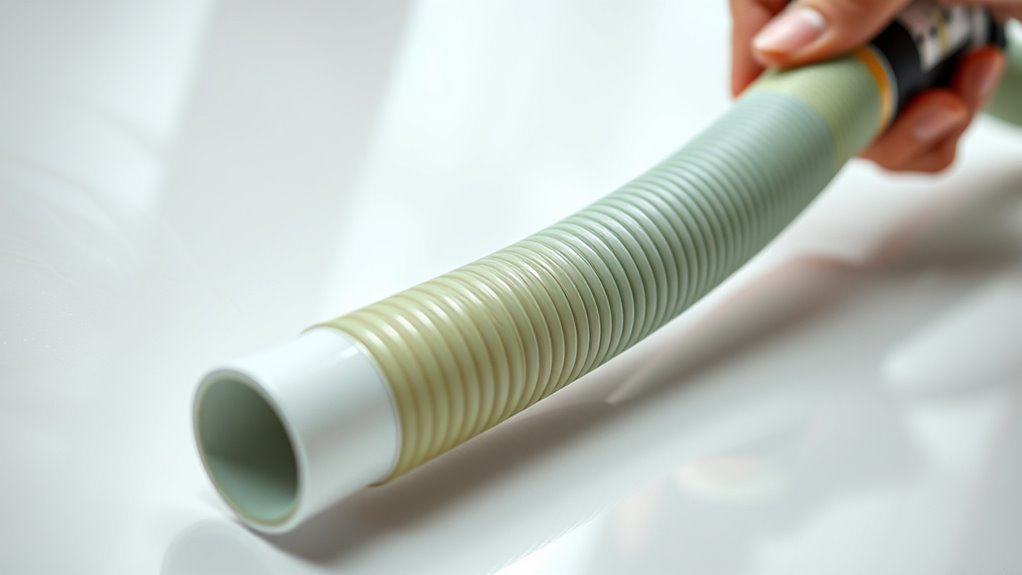
As you increase hose length, you might notice pressure drops that affect your spray quality. Longer hoses can cause uneven spray patterns and inconsistent material flow, making your finish less smooth. Understanding these effects helps you choose the right hose length for the best results. Additionally, using proper accessories like strainers and extension wands can mitigate some issues caused by longer hoses. Being aware of fluid dynamics can also help in selecting hoses that maintain optimal pressure throughout your project. Recognizing how hose diameter impacts flow rate can further improve your spray consistency, and considering pressure regulation devices can help maintain steady pressure regardless of hose length. Moreover, understanding the pressure loss over extended distances can guide you in selecting the most suitable hose for your specific spraying needs.
Pressure Drop Effects
Longer hoses can cause a significant pressure drop, which directly affects your spray consistency and overall quality. As pressure decreases, you might notice uneven spray patterns or inconsistent paint flow, leading to a subpar finish. To mitigate this, choose hoses with good hose durability that can handle pressure loss without damage. Proper storage solutions also help maintain hose integrity, preventing kinks or leaks that could worsen pressure issues. Keep in mind that increased pressure drop can strain your sprayer, reducing its lifespan if not managed properly. Measuring your hose length carefully ensures you balance flexibility with performance, maintaining steady pressure and achieving professional results. Avoid overly long hoses that compromise pressure, and opt for quality hoses stored correctly for peak performance. Additionally, understanding pressure drop effects can help you select the optimal hose length for your spraying needs. Being aware of hose material properties can further enhance your ability to choose the right hose for durability and minimal pressure loss. Selecting hoses with appropriate diameter can also help minimize pressure loss and improve spray consistency over longer distances. Remember, balancing hose length with the desired spray quality is crucial for achieving a professional finish.
Spray Pattern Uniformity
Hose length directly impacts spray pattern uniformity, influencing how evenly your paint is applied. Longer hoses can cause pressure fluctuations, leading to inconsistent spray patterns that affect color blending and overall finish quality. This pressure drop can result in uneven coats or visible brush strokes, especially in detailed work. To maintain a consistent spray pattern, choosing the right nozzle is vital, as it helps compensate for pressure variations caused by hose length. A nozzle designed for higher pressure or with adjustable settings can improve spray stability. Keep in mind that shorter hoses generally promote better uniformity, but if you need a longer hose, consider upgrading your equipment or adjusting your nozzle selection to guarantee your spray pattern remains smooth and even. Additionally, understanding Hackathons and their collaborative environments can inspire innovative solutions for optimizing equipment setups.
Material Flow Consistency
Hose length plays a significant role in maintaining consistent material flow, which directly affects the quality of your spray application. When the hose is too long, it can cause pressure drops, leading to uneven material delivery. This inconsistency impacts color mixing, resulting in uneven shades or streaks. Proper hose length ensures steady flow, helping your paint mix evenly and spray smoothly. It also maintains nozzle compatibility, preventing disruptions that can cause clogs or uneven atomization. If the hose is too short, you might struggle with reach, but an excessively long hose can dilute pressure, compromising spray precision. Balancing hose length helps you achieve a uniform finish, with consistent color application and perfect nozzle performance. Ultimately, controlling material flow through appropriate hose length enhances your overall spray quality. Additionally, using the correct hose length supports material flow consistency, which is crucial for achieving professional results. Proper hose management also minimizes pressure loss, ensuring your sprayer operates efficiently and effectively. Maintaining optimal hose length can also reduce hose wear and tear, prolonging the lifespan of your equipment. Selecting the appropriate hose length also helps prevent clogging issues, which can disrupt your workflow and lead to appliance downtime.
Effects of Longer Hoses on Pressure and Flow Rate
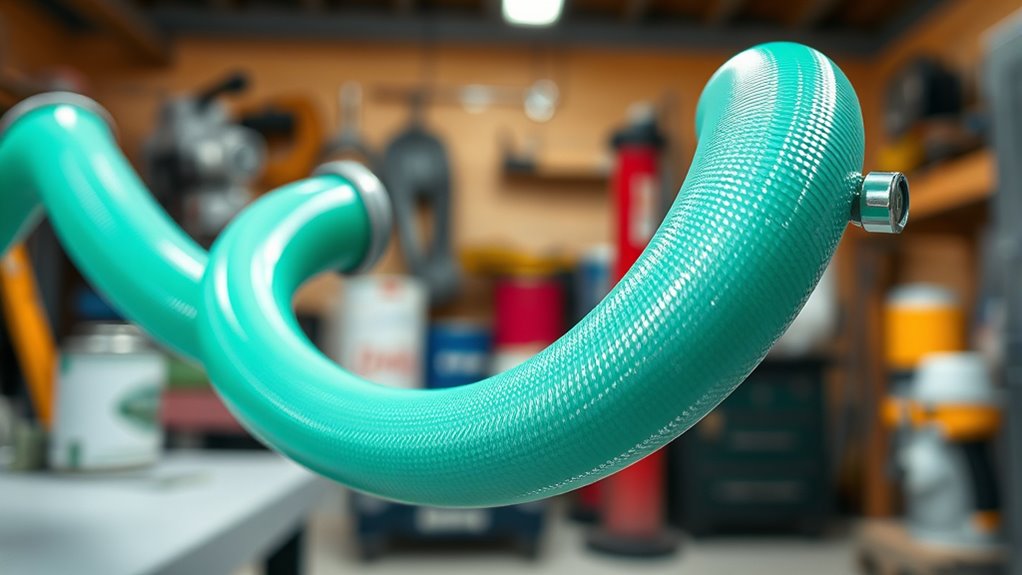
When you use longer hoses, you’ll notice a drop in pressure and a decrease in flow rate. This means your spray might become less consistent or take longer to finish. Additionally, the hose’s flexibility can influence how smoothly the paint is delivered. Moreover, selecting a hose with appropriate material quality can help mitigate some of these issues, ensuring better durability and performance during your spraying tasks. Understanding how hose length impacts pressure and flow is essential for achieving a professional finish, especially since smart technology features in modern tools can optimize operation even with varying hose lengths.
Pressure Drop Increase
As you increase the length of your paint sprayer hose, you’ll notice a rise in pressure drop, which can considerably impact your spraying performance. Longer hoses create more resistance, causing the pump to work harder to maintain consistent pressure, leading to uneven spray patterns. This increased pressure drop can strain hose durability, making it more prone to leaks or damage over time. To minimize issues, choose hoses designed for longer lengths and consider proper storage solutions that prevent kinks or twists, which can further increase pressure loss. Regularly inspecting and maintaining your hoses ensures they stay in good shape and helps sustain ideal pressure levels. Additionally, understanding industry trends can guide you in optimizing equipment performance and durability. Keep in mind that extending hose length might require adjustments to your sprayer settings to achieve the desired finish.
Flow Rate Reduction
Ever wondered how a longer hose affects your spray flow? As you increase hose length, you’ll notice a reduction in flow rate due to higher pressure loss. This means your sprayer delivers less paint per second, which can impact your brush technique, forcing you to adjust your movements for even coverage. The decreased flow can also influence paint adhesion, especially on larger surfaces, since inconsistent application may result. To maintain ideal, consider shortening your hose or upgrading to a model with better pressure compensation. Remember, a longer hose isn’t just about reach—it can subtly compromise your spray pattern and consistency, making it harder to achieve a smooth, even finish. Being aware of this helps you adapt your technique for better performance.
Hose Flexibility Impact
Longer hoses tend to reduce pressure and flow rate because their increased flexibility can cause internal pressure drops. Flexible hoses bend and twist more easily, which creates slight resistance and disrupts steady fluid movement. This reduced internal pressure can lead to uneven spray patterns and slower application. The material durability also plays a role—more durable materials often maintain their shape better, minimizing pressure loss. Conversely, less durable, more flexible materials may degrade or kink over time, further impairing flow. When selecting a hose, consider both flexibility and material durability to guarantee consistent pressure and flow. A balance between flexibility for maneuverability and material strength for longevity helps maintain ideal spray performance, especially with longer hoses that are more prone to internal pressure drops.
Advantages of Short Hoses for Precision and Control

Short hoses give you better control and greater precision when painting. With a shorter hose, you can move the sprayer more easily, ensuring smooth, consistent application. This reduces overspray and uneven coats, making your work more efficient. Shorter hoses also simplify paint sprayer maintenance since they’re easier to handle, clean, and store. Proper hose storage solutions become more straightforward, preventing kinks and damage that could affect performance. Plus, reduced hose length minimizes drag, giving you more precise control over spray patterns. Overall, shorter hoses help you stay focused on your technique, resulting in higher-quality finishes. Keep in mind that while they offer these advantages, they also contribute to better hose management, making your painting process more streamlined and effective.
When to Opt for Extended Hoses in Large-Scale Projects
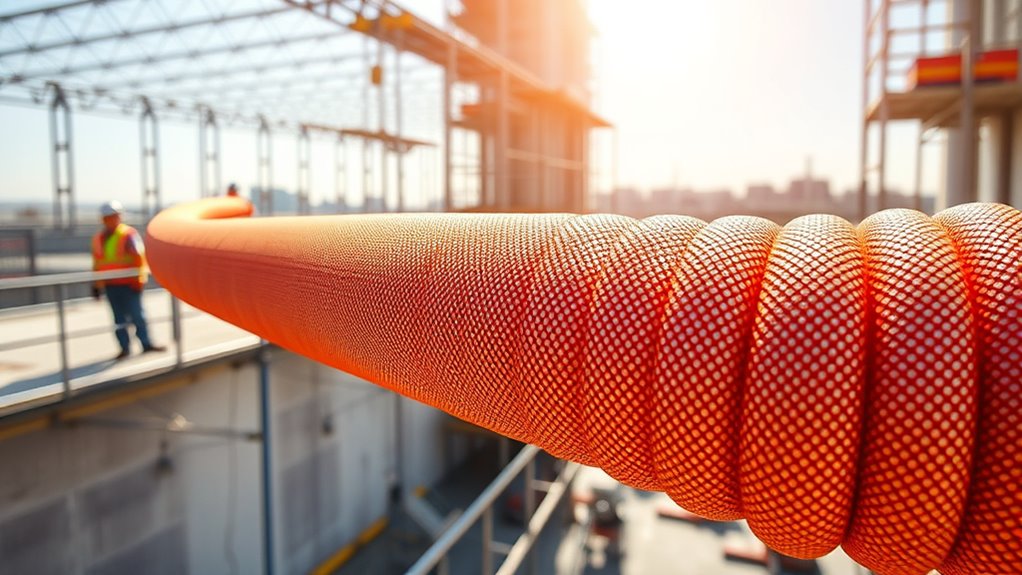
When tackling large-scale projects, extended hoses can give you greater mobility to cover wide areas without constantly moving the sprayer. However, keep in mind that longer hoses may cause some pressure loss, which can affect the spray quality. Weigh these benefits and potential drawbacks to decide if an extended hose is right for your job.
Increased Mobility Benefits
Opting for extended hoses in large-scale projects considerably enhances mobility, allowing you to move freely across expansive work areas without constantly switching outlets or repositioning equipment. This flexibility means you can seamlessly reach different sections, maintaining consistent paint color application and smooth brush strokes. With an extended hose, you’re less likely to trip over cords or get tangled, which helps keep your workflow efficient. You can easily adjust your position to ensure even coverage, especially when working on large walls or ceilings. This increased mobility reduces fatigue and saves time, enabling you to focus on achieving a flawless finish. Overall, longer hoses give you the freedom to work more comfortably and efficiently, making large-scale projects much more manageable.
Potential Pressure Loss
Extended hoses can cause a drop in water pressure, which may affect the spray performance during large-scale projects. When using longer hoses, you might notice uneven spray patterns or reduced atomization, making your work less efficient. Proper hose storage prevents kinks and damage that can worsen pressure loss. If you opt for extended hoses, consider models with color options that help quickly identify length and prevent accidental disconnections. Keep in mind that pressure loss isn’t just about hose length but also about internal diameter; larger diameters help maintain pressure. If pressure drops considerably, you may need a more powerful pump or shorter hoses for critical tasks. Being aware of potential pressure loss ensures you select the right hose length and accessories for smooth, consistent spraying on big projects.
Common Challenges With Excessively Long Paint Sprayer Hoses
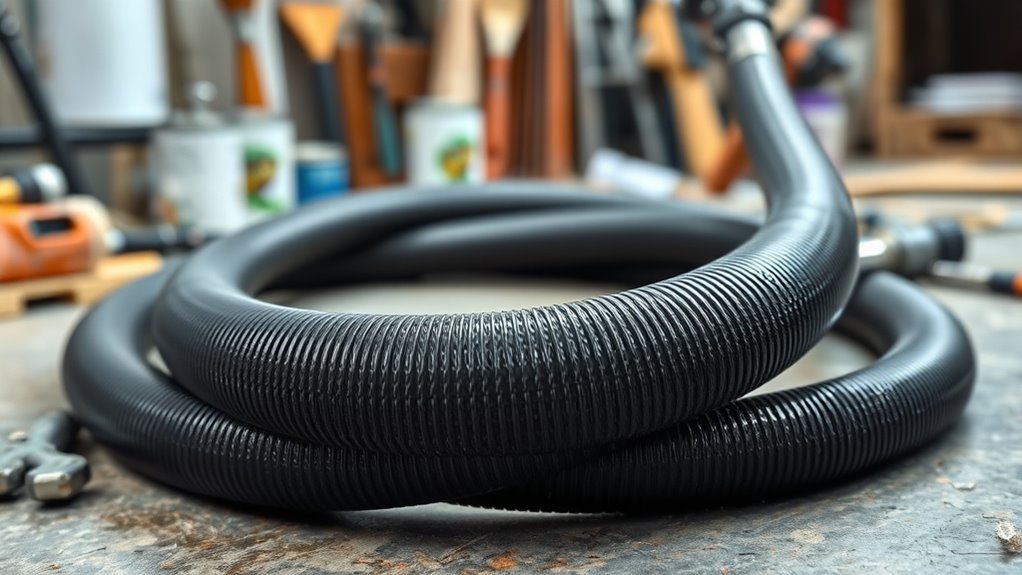
Excessively long paint sprayer hoses can introduce several practical issues that hinder your painting projects. One major challenge is reduced spray pressure, which can cause uneven coating and longer job times. Additionally, managing longer hoses complicates paint sprayer maintenance, making cleaning and troubleshooting more difficult. You might find it harder to control the spray pattern and achieve consistent coverage. Storage becomes another concern; bulky hoses can tangle or deteriorate if not stored properly. To prevent these problems, use proper hose storage techniques to avoid kinks and damage. Shorter hoses generally help maintain ideal pressure and simplify maintenance routines. Recognizing these challenges ensures you can plan your equipment setup for smoother, more efficient painting sessions.
Tips for Selecting the Right Hose Length for Different Jobs

Choosing the right hose length for your painting project can make a significant difference in both efficiency and quality. To select the best length, consider these tips:
Selecting the correct hose length enhances efficiency, safety, and painting quality.
- Match the hose length to the size of the job—longer hoses are great for large areas, but avoid excessive length that hampers maneuverability.
- Keep safety precautions in mind—shorter hoses reduce tripping hazards and minimize accidental disconnections.
- Think about color mixing — a flexible, appropriately sized hose prevents unnecessary stops, ensuring consistent color flow.
Always check your hose for proper fittings and avoid overly long hoses that cause pressure drops. Proper length not only improves performance but also ensures safety, reducing risks during operation. Choose wisely to achieve smooth, high-quality results.
Impact of Hose Material and Diameter on Performance
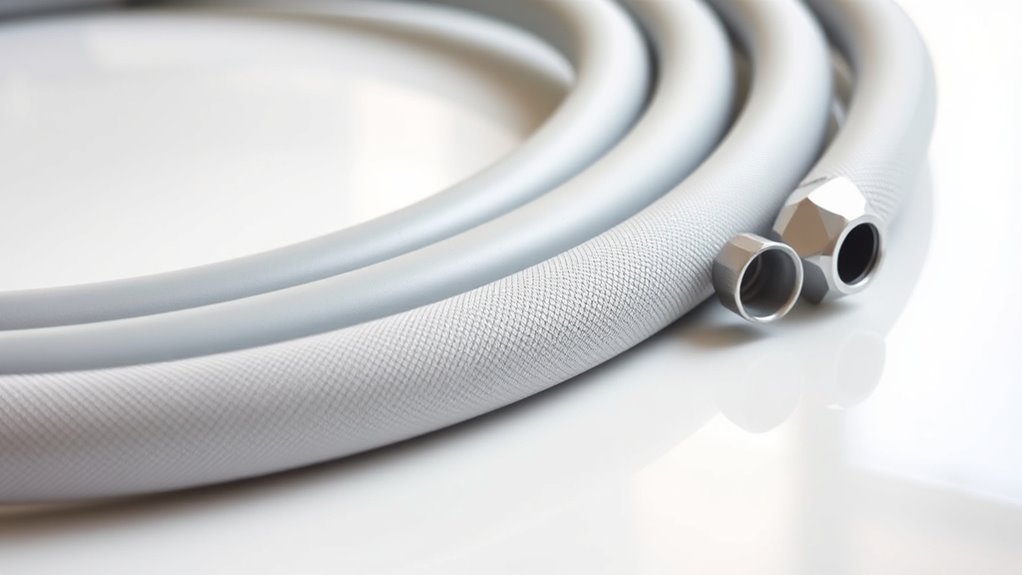
The material and diameter of your paint sprayer hose directly influence its performance, affecting factors like flow rate, pressure, and durability. A hose material such as reinforced rubber or polyurethane can withstand higher pressures and resist wear better, ensuring consistent spray performance. The hose diameter also plays a vital role; a larger diameter allows more paint to flow with less resistance, maintaining steady pressure and reducing strain on your sprayer. Conversely, a smaller diameter may increase pressure, risking nozzle clogging or inconsistent coverage. Choosing the right hose material and diameter helps optimize your spraying experience, ensuring smooth operation and even application. Pay attention to these factors to prevent performance issues and extend the lifespan of your equipment.
Balancing Flexibility and Stability in Your Hose Choice

Selecting the right hose involves finding a balance between flexibility and stability to suit your spraying needs. Too flexible, and the hose may kink or drag, reducing efficiency; too stiff, and maneuverability suffers. To achieve this balance, consider these points:
Choosing a hose with the right balance of flexibility and stability ensures efficient, safe spraying and easy storage.
- Hose durability: Choose materials that resist wear and tear, ensuring the hose maintains stability over time.
- Flexibility: Opt for a hose that’s easy to maneuver without sacrificing stability, especially in tight spaces.
- Storage considerations: Select a hose that’s easy to coil and store without damage, maintaining both flexibility and durability.
Balancing these factors helps prevent issues like leaks or kinks while making your workspace safer and more efficient. Your choice impacts performance, hose longevity, and storage ease.
Practical Recommendations for Optimal Hose Length Usage

To guarantee efficient and safe painting sessions, using the right hose length is essential. Start by selecting the appropriate length based on your project size and workspace layout. Too long a hose can cause tangling and reduce pressure, while a short one may limit mobility. When choosing paint sprayer accessories, opt for hoses that balance reach and manageability. Proper hose storage helps maintain hose integrity and prevents damage, ensuring consistent performance over time. Coil hoses neatly and store them in a cool, dry place to avoid kinks and wear. If you need extra length, consider using extension hoses, but keep the total length manageable. By following these practical tips, you’ll optimize your hose setup for smooth, efficient painting.
Frequently Asked Questions
How Does Hose Length Affect Overall Painting Project Efficiency?
Hose length directly impacts your painting project efficiency by affecting mobility and ease of use. A longer hose allows better hose storage and greater reach without constantly moving the sprayer, but it can diminish spray nozzle pressure, leading to uneven application. Shorter hoses increase pressure consistency but limit flexibility. Balancing hose length ensures smooth movement, maintains consistent spray quality, and prevents strain on the equipment or your arm during extended projects.
Can a Longer Hose Cause Equipment Overheating?
A longer hose can feel like a giant snake, but it won’t cause your equipment to overheat if it’s well-made. The key is hose durability; a sturdy hose handles extended lengths without overheating or damage. Just make sure your spray nozzle and hose are compatible, and avoid cranking the pressure too high, which can lead to overheating. Properly maintained hoses ensure smooth operation, regardless of length.
What Is the Maximum Recommended Hose Length for Home Use?
For home use, the maximum recommended hose length is typically 25 to 50 feet, depending on your sprayer model. Longer hoses can make hose storage and maintenance more challenging, and may affect spray pressure. To keep your sprayer working efficiently, regularly check for hose wear, clean it properly, and avoid kinks. Proper hose storage guarantees longevity, and maintaining the right length helps prevent performance issues during your projects.
Does Hose Flexibility Impact Spray Pattern Consistency?
Imagine you’re painting a large wall, and your hose’s flexibility allows smooth movement. If your hose is too stiff, it might kink or restrict flow, impacting spray pattern accuracy. Flexible hoses tend to maintain consistent spray patterns better because they resist kinking, boosting hose durability. So, choosing a flexible hose helps you achieve even coverage and prevents interruptions, ensuring your paint job stays smooth and professional throughout.
Are There Specific Hose Materials Better for Long-Distance Spraying?
When choosing a hose for long-distance spraying, you should consider hose materials that offer better durability and material compatibility. Flexible hoses made from reinforced rubber or polyurethane tend to withstand extended use and resist wear better. These materials guarantee your hose stays intact under pressure, reducing leaks and maintaining consistent performance. Picking the right hose material helps you achieve smooth, efficient spraying over longer distances without sacrificing quality or durability.
Conclusion
Choosing the right hose length is like finding the perfect dance partner—you need just the right fit to keep your workflow smooth. Short hoses give you precision, while longer ones extend your reach for big projects. Consider your job’s scope, pressure needs, and maneuverability. When you match your hose to your task, you’ll flow effortlessly, turning each project into a masterpiece rather than a tangled mess. Your ideal hose length is the secret to painting with confidence and control.
A seasoned painter with over 15 years in the industry, Mike transitioned from hands-on painting projects to the digital world of paint sprayers. His extensive experience gives him a unique perspective on what users truly need when it comes to painting tools. As the Editor in Chief of Paint Sprayer Zone, Mike ensures that every piece of content not only provides value but also reflects the realities of painting — the challenges, the joys, and the intricate details.
